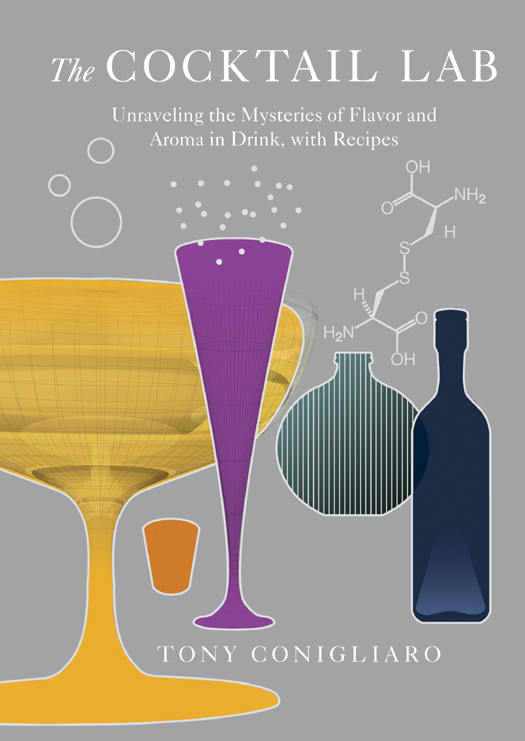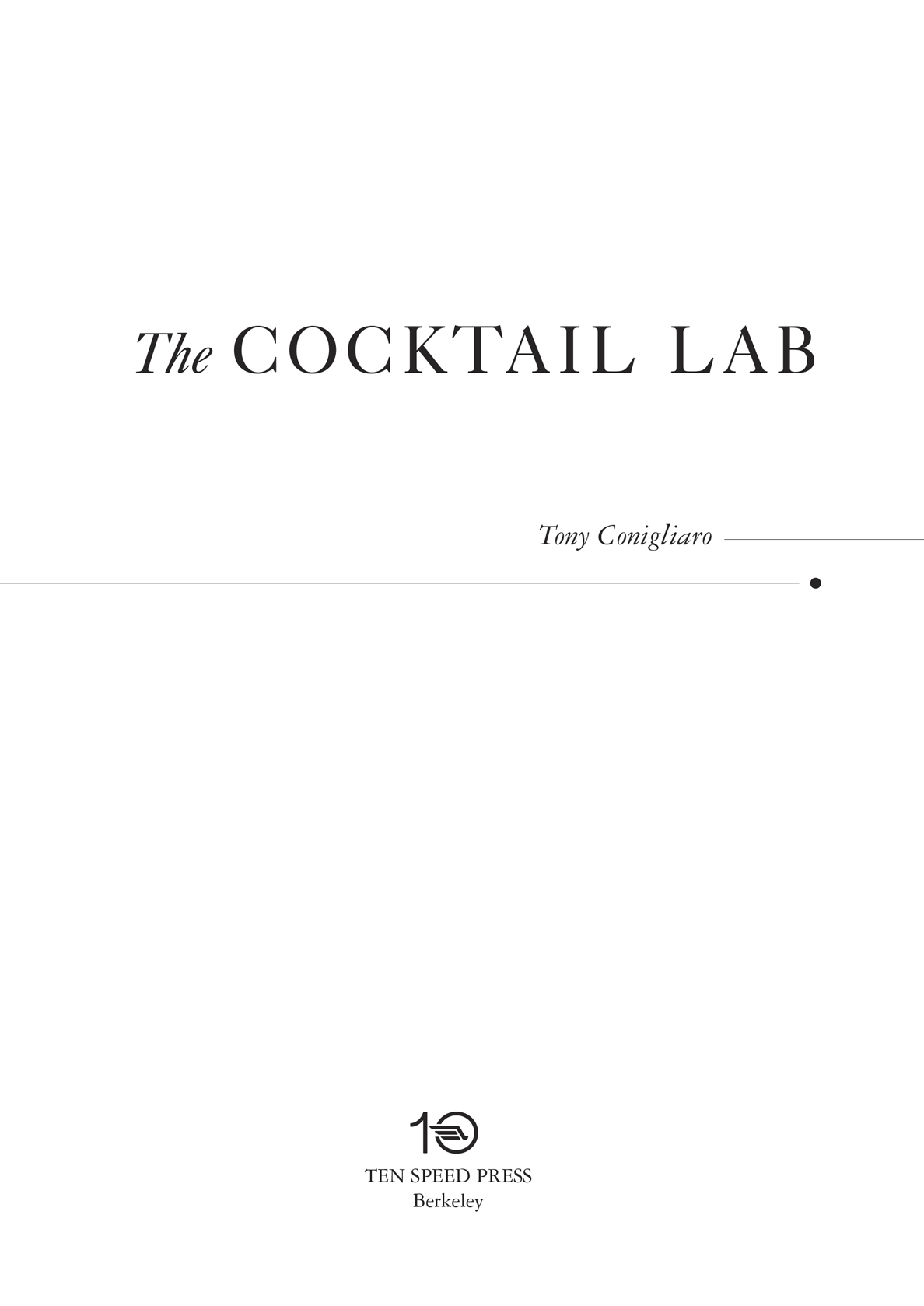Tony Conigliaro is a revolutionary. He is at the forefront of a new energy in cocktail making. His research is exhaustive and his commitment has resulted in some delicious and innovative cocktails.
His inspiration comes from such diverse extremes as movies and perfumes and his knowledge of alcohol history dates back to alchemy itself. He has a great insight into the spirits and the alcohol he uses and the various processes of their creation. This solid foundation of knowledge is the building block for his creativity. His respect and understanding of the produce he uses in his drinks result in delicious, intense flavors as he pushes the rules of classic cocktail making beyond expectation.
Tonys enthusiasm does not just stop with the drink in the glass. He is concerned with every component, from the presentation, color, smell, type of receptacle used, to the way in which the ice is frozen and its effects on taste and flavor. By using modern equipment not normally associated with the tools of a cocktail barman, Tony manages to extract the best possible flavors from his marinades and infusions, resulting in a cleaner, sharper quality of cocktail. His commitment to research and development is a breath of fresh air, and he has a strong focus on reinventing iconic classics.
With the publication of the recipes in The Cocktail Lab , the skill and enthusiasm that Tony brings to the industry, combined with his pure raw energy, will help the enthusiast to unfold the mysteries surrounding his philosophy and approach to cocktail makingand maybe trigger a few ideas of their own.
H ESTON B LUMENTHAL
Copyright 2012, 2013 by Tony Conigliaro
Photographs copyright 2012 by Ebury Press
All rights reserved.
Published in the United States by Ten Speed Press, an imprint of the Crown Publishing Group, a division of Random House, Inc., New York.
www.crownpublishing.com
www.tenspeed.com
Ten Speed Press and the Ten Speed Press colophon are registered trademarks of Random House, Inc.
Originally published in slightly different form in Great Britain as Drinks: Unravelling the Mysteries of Flavour and Aroma in Drink by Ebury Press, an imprint of Ebury Publishing, a Random House Group Company, London, in 2012
Library of Congress Cataloging-in-Publication Data is on file with the publisher.
eBook ISBN: 978-1-60774-568-6
Hardcover ISBN: 978-1-60774-567-9
Photography by Addie Chinn
Illustrations by Juri Nishi
v3.1
For my mentors Richard Dick Bradsell, Rainer ja ja Becker for believing in me, and my dear friend Audrey smell this Saunders, for all the incredible walks and talks.
And for Ria my Lighting Bolt Soler, well, for being the lighting bolt.
Last but not least, Gemma youre driving me mad Reeves, without whom this book would not be possible.
Contents
I.
INTRODUCTION
In The Beginning There Was Art
Theres a beginning to every story. This story begins in a white box-room with a sink, a rickety secondhand chair, an easel, and a tablethe top of which was piled with bills. It was in this room that I discovered that supporting yourself after art school is as challenging as life at art school! After studying fine art and art history in London, I specialized in painting and experimented with using aroma in paint. In this sense, Ive always been interested in working in one arena but exchanging ideas with an entirely different discipline. More from necessity than anything else, I began working in the bar industryquite simply, I needed to fund my studio work. The crossover between the two disciplines was truly surprising. I had no idea of the creativity involved in working with cocktails. The two passions overlapped and then slowly one overtook the other. And so my love affair with liquids began.
Although art and cocktails seem to be disparate disciplines, they are both about appealing to sensory experience. At art school I read a lot about the philosophy of aesthetics and I asked myself questions all the time: why does one thing appeal to the senses over another, or appeal to just one of our senses rather than all? I think that there is real beauty in simplicity, in functionality. Cocktails are often talked about with a lack of sentimentality, yet many find it easy to become rapturous over wine. When I began to work in the bar industry the focus started to shift. I wondered: why is flavor in liquids beautiful?
And Then There Was Flavor
When we ask questions about flavor, our natural response is to turn to the culinary experience as a frame of reference. I love to cook and I revel in the dining experience. Growing up in a Sicilian family, Ive always been surrounded with simple, flavor-packed home cooking. I taste dishes over and over again, comparing similar flavors, using the same ingredients with different variations. One of my favorite dishes to cook at home is wild mushroom risotto. Over the years Ive honed the recipe to perfection and this is because the devil really is in the detail. Each element of the risotto is important; its about using just the right amount of stock, the quality and variety of the mushrooms, and I replace white wine with dry vermouth for a lovely nutty flavor. The enjoyment of the finished dish is dependent upon all these small details working in harmony to achieve the perfect final texture.
In fact, much of what we enjoy about food is centered around texture and chewing, but with liquids the mechanism of how you taste is different. People tend to think that taste is just flavor on the tongue, but in actuality the salty/sweet/sour aspects of flavor are also like toucha sensation, not just a flavor in themselves. Flavor is only really released when you swallow something. At the back of your palate is the epiglottis, which is open when you breathe; when you swallow, it closes so that the liquid doesnt flow down into your airways. When it reopens, it releases a reflux of aroma molecules back into the olfactory chamberso when youre tasting something, youre really smelling it. Therefore, the majority of taste is smell, and this is also why the way in which we enjoy cocktails can have much in common with how we enjoy perfumes as well as food.
For this reason, when it comes to liquids there is little or no distraction of texture, of masticatingno knife, no fork. Alcohol can be a fantastic vehicle for delivering immediate flavor. In this sense we are slaves to the first few seconds of taste and it is in those moments that well decide whether or not we like a cocktail; our decision whether we love or loathe a drink is rarely an afterthoughtthe flavor may keep on developing in our mouth, but it wins or loses at that first point. Theres a huge challenge in this: to fulfill a persons sensory experience immediately!
Cocktails are a niche market and they inhabit a nebulous space. They dont sit comfortably in the food category, but because they are ingested rather than inhaled it doesnt feel right to consider them in the same spectrum as perfume either. Part of understanding the beauty in liquid flavor comes from trying to find a language that expresses working with liquids for liquids sake. One of the first steps in creating your own language is to borrow the terminology and signifiers, and when talking about cocktails it makes sense to turn to cocktail historians, perfumers, and chefs. Challenging the traditional approach to working with alcohol and the language we use to discuss it is no easy feat. Talking about how booze makes you feel is almost a taboo subjectessentially we are discussing the effects of a drug, so how can this be arthow can this be beautiful? People will drink alcohol whether or not it tastes good; we dont grow up drinking alcoholic drinkswe havent spent a lifetime drinking in the same way that we have eating. And so we have to educate our palates much later in life. I think, however, that there is an inherent sense of artistry in drink because of its frivolityyou dont need to have a Bellini, but its a damn good feeling when you do.




